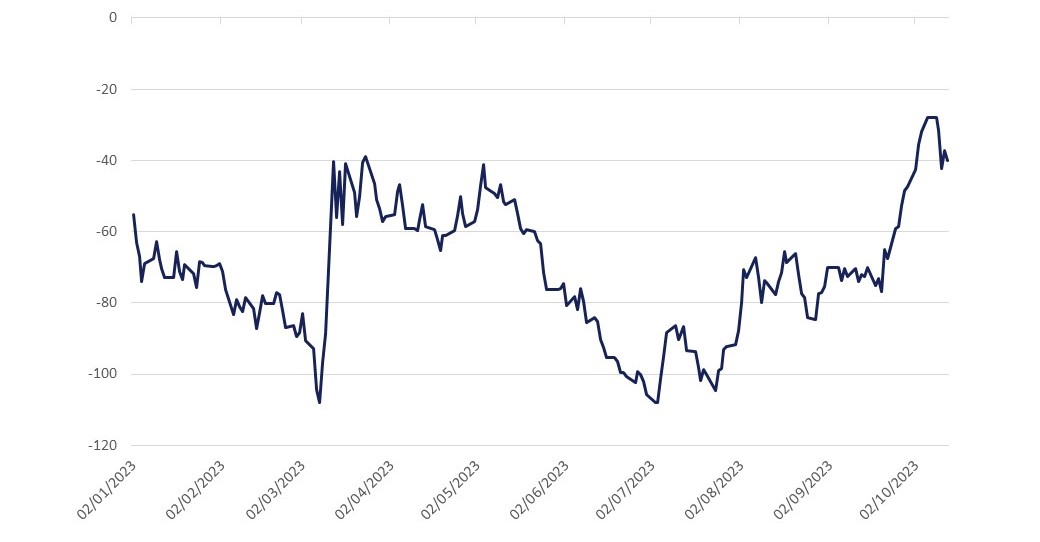The brutal attacks over the weekend in Israel by Hamas marked the worst escalation of conflict in the area since the breakout of the Yom Kippur war 50 years ago. The fallout on the global economy may take time to become clear, however the implications may become more severe should the conflict spread to the rest of the Middle East.

The world is closely watching Iran, a major oil producer and supporter of both Hamas and Hezbollah. The US has warned Iran and other actors not to get involved and recently pushed Qatar to halt Iran from accessing the $6bn they were due to receive from the recent prisoner deal.
History tells us that geopolitical events drive short-term market movements but don’t usually have long-term lasting impacts on markets. However, it is worth noting that geopolitical risk is already elevated with the Ukraine war, tensions between the US and China, and now with escalating violence in the Middle East. Wars in this region can be inflationary, as seen with the oil crisis in the 1970s in the aftermath of Yom Kippur. On Monday, oil prices jumped around 4%, as fears of further escalation of the conflict towards other Middle Eastern nations poses a major threat to oil supply. Over the past week, investors have been grappling with potential rising oil prices. This would put further pressures on real incomes across the globe. Should the crisis remain contained between Israel and Gaza, there is little threat to global oil supply. The market showed growing confidence in the conflict remaining localised as oil prices remain little changed following the jump on Monday.
However, if the US and Iran, along with other Middle Eastern nations get embroiled, we could see not only a major impact on oil prices, but also extreme volatility in other asset classes. US President Joe Biden pledged his unwavering support for Israel, and it appears to have had little repercussions in terms of oil production for now. For historical context, the support of the US and other nations led to the1973 oil embargo which sent oil prices skyrocketing. However, a tougher stance on Iran could further tighten global oil supplies, making it difficult for the US to keep domestic gasoline prices low. We expect commodity markets to remain jittery for some time.
This comes at a time when the global economy is facing a ‘higher for longer’ interest rate environment. Central banks have been pursuing an aggressive interest-rate hiking cycle for years to combat inflation. The odds central banks will cut rates on softening demand just became more remote.
In previous pieces, we noted how longer dated bond yields rose materially over the summer months. This week, several Fed members came out and said these moves may have done their work for them. On Tuesday, Atlanta Fed President Raphael Bostic went so far as to say, “I actually don’t think we need to increase rates anymore.” This combined with the geopolitical events remaining contained so far drove a large bond rally. The two-and-10-year yield curves continued to unwind the aggressive steepening seen over the past few months, with this un-inversion consistent with the Fed’s language it would back off interest rate hikes. This language also indicated that the hurdle rate for a further rate hike increased. However, some have raised concerns on the fiscal trajectory of the US, which is currently operating with a large deficit, something that will only grow with increased military spend and higher debt servicing costs.

Both the US Producer Price Index (PPI) and the Consumer Price Index (CPI) came in hotter than expected, showing inflation remains stubbornly high. The CPI data in particular indicates stickiness in rents in the US, at a time when 30-year mortgages in the US are at their highest level in over 20 years. Despite both PPI and CPI coming in a bit hotter than expected, it seems the market generally took comfort from the more dovish tone from the Fed that suggests tighter financial conditions that are yet to fully feed through may well imply that this hiking cycle is over.
We offer our deepest sympathies to those affected by these terrible events. We are monitoring events closely and will continue to keep you informed as actions unfold.
This communication is provided for information purposes only. The information presented herein provides a general update on market conditions and is not intended and should not be construed as an offer, invitation, solicitation or recommendation to buy or sell any specific investment or participate in any investment (or other) strategy. The subject of the communication is not a regulated investment. Past performance is not an indication of future performance and the value of investments and the income derived from them may fluctuate and you may not receive back the amount you originally invest. Although this document has been prepared on the basis of information we believe to be reliable, LGT Wealth Management UK LLP gives no representation or warranty in relation to the accuracy or completeness of the information presented herein. The information presented herein does not provide sufficient information on which to make an informed investment decision. No liability is accepted whatsoever by LGT Wealth Management UK LLP, employees and associated companies for any direct or consequential loss arising from this document.
LGT Wealth Management UK LLP is authorised and regulated by the Financial Conduct Authority in the United Kingdom.